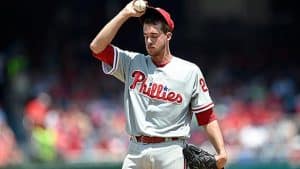

Well, let’s think about this for a second.
Why is Nola suddenly as infected as everyone else in this starting rotation? How come every single Phillies starter has been, at best, mediocre this season?
Here’s something: I can argue that every starting pitcher employed by the Phillies this season has, in 2017 with the Phils, performed worse than ever in his professional career.
Jeremy Hellickson: The eight-year veteran was rocked to a 5.17 ERA in 2013 with Tampa Bay, but his FIP that year was just 4.22. This year’s FIP? 5.54. His BB/9 (2.2) remains good, but his strikeout rate has dropped sharply, from a career average around 7 to just 3.6 this year. He’s never had a K/9 fewer than 5.6 (2011). He has also allowed 11 home runs; over a full season it would be 32, a career high by seven.
Aaron Nola: Last season Nola went down with an elbow injury, which many believe affected his performance last year (4.78 ERA). Still, his K/9 was an outstanding 9.8 and his BB/9 rate was 2.4, in line with his major league average. But this year? His 4.34 ERA (and climbing) comes with a 7.8 K/9 (more like his major league average) and a 3.1 BB/9, which is way out of line for Nola. If you want to contrast that with his extremely small triple-A sample from this year, he had an 8.7 K/9 and 0.9 BB/9 over 10.1 innings. It’s as if major league 2017 Nola is different from any Nola we’ve ever seen.
Jerad Eickhoff: As a major leaguer, Eickhoff is more than a full run of ERA worse than in 2016 (which was a full run worse than in 2015). That doesn’t tell an accurate story, but like Nola, Eickhoff’s walk rate has climbed to level he hasn’t seen since 2014 (3 BB/9), when he was in double-A. His H/9 rate is way up, too – 10.1 is the highest it’s ever been; the closest he’s come to 10 hits per nine is 9.4 … when he was in A-ball in 2012.
Vince Velasquez: Major league Velasquez before 2017 showed immense promise, balancing frustrating performances with superb pitching. But now? The strikeout rate is in line (9.5/9) as is the walk rate (3.8/9, though slightly elevated). The difference is the home runs. He’s given up 2/9, way up from the 1.4/9 of 2016. The hits per 9 (9.4) are up almost a full hit, too. He’s never had numbers this poor, and you’d think with more major league experience he’d settle in.
Zach Eflin: Poor Zach. Already sent back to triple-A, Eflin this season has a 6.13 ERA, 5.91 FIP, 2.1 HR/9 and 11.1 H/9, without question the worst numbers of his professional career. His walk and strikeout rates are better than 2016, but marginally so. In fact, major league Eflin is an entirely different pitcher from triple-A Eflin, double-A Eflin, and so on.
Nick Pivetta: Pivetta in 2017: 5.12 ERA, 5.78 FIP, 4.2 BB/9, 12.1 H/9. His walk rate once reached 4.0 (2015 in advanced-A and double-A ball), but he surrendered 3.5 fewer hits per nine that year. But the ERA has never been this bad. The hittability has never been this clear.
Jake Thompson: This is an extremely small sample size, but Thompson in 2017 has seen numbers like he’s never put up before. A 7.2 BB/9 eclipses everything he’s done. The 6.84 FIP is atrocious. And while he’s giving up a ton of hits in Lehigh Valley this year (11.2/9), he’s only giving up 0.4 home runs per nine (it was 1.8 HR/9 in Philly).
Here’s the weird thing: Thompson was fantastic all the way until he came to Philadelphia. In 2016 for the IronPigs he put up a 2.50 ERA with a 2.6 BB/9 and 6.0 K/9 – respectable numbers, but made better as he limited hits (7.3/9) and longballs (0.7/9). Then he came to Philly and everything jumped; since, he hasn’t pitched well *except* the home run totals decreased in Lehigh Valley this year.
Hell, even Clay Buchholz, who had just two terrible starts with the Phils before injury, may have never been worse than in those two starts. His walk rate and strikeout rate were consistent with 2016 (even in that small sample size), but he gave up 16 hits in seven innings.
The point is this: It’s very curious that every single starter has arguably never looked worse. And that includes the minor leagues. You should expect young pitchers to struggle upon entering the majors, but you’d think the law of averages alone would make one of these seven starters better, but no, every one of them has fallen off expectation and trajectory.
Sure the pitchers can be blamed for some of this. But for these seven, during their time in Philly, there are a couple constants that need to be addressed (whether it’s the manager, the pitching coach, the catchers, philosophy, communication, whatever).
But something needs to be addressed now, before it’s really too late.